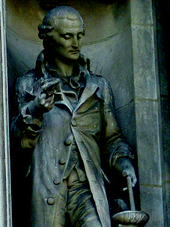, Maneli Mozaffarieh1 and Hans Bebie2
(1)
Department of Ophthalmology, University of Basel, Basel, Switzerland
(2)
Institute for Theoretical Physics, University of Bern, Bern, Switzerland
Abstract
Related sciences such as physics, chemistry, and biology merge seamlessly into each other, which makes it difficult for us to clearly distinguish among these sciences. The terms “biophysics,” “physical chemistry,” or “biochemistry” imply the flowing connectivity between scientific fields. The topics in this book are, therefore, assigned to the various scientific chapters somewhat arbitrarily.
Related sciences such as physics, chemistry, and biology merge seamlessly into each other, which makes it difficult for us to clearly distinguish among these sciences. The terms “biophysics,” “physical chemistry,” or “biochemistry” imply the flowing connectivity between scientific fields. The topics in this book are, therefore, assigned to the various scientific chapters somewhat arbitrarily.
What is the link between ophthalmology and chemistry? Chemistry is the basis of biology, which, in turn, provides information about the function of the eye. Chemistry is the science of the composition, structure, properties, and reactions of matter. We shall begin by describing some of the first steps toward modern chemistry.
8.1 First Steps Toward Modern Chemistry
The “father of modern chemistry” was the French chemist Lavoisier,1 the son of a prominent advocate, born to a wealthy family in Paris. At Lavoisier’s time, chemistry was so underdeveloped it could hardly be called a science. The main view of combustion, or burning, was that of the “Phlogiston Theory,” which stated that certain materials contain a fire-like element called “Phlogiston,” which was liberated by burning; conversely, when those materials were heated, the “phlogiston” entered the material. One major problem with this theory was that, when some metals such as magnesium (which were considered to be rich in phlogiston) were oxidized, the resulting oxidized metal was heavier than the initial metal even though it was supposed to have lost weight. Lavoisier disproved the phlogiston theory by showing that combustion required a gas, oxygen, which had a weight. In a paper titled “Memoir on Combustion in General,” he presented his theory that combustion was a reaction in which oxygen combines with other elements. A simple example is the combustion reaction between hydrogen and oxygen (Fig. 8.1).


Fig. 8.1
Combustion reaction. Hydrogen reacts with oxygen in a combustion reaction to produce water and heat
Lavoisier also discovered that, in a chemical reaction, matter is neither created nor destroyed, known as the “law of conservation of matter” (the mass of the reactants equals the mass of the products). For the first time, he formulated chemical reactions in the form of chemical equations based on the conservation of mass. Lavoisier was among the first to have a clear concept of a chemical element and the first to list the known elements. He was also the first to develop a rational system for naming chemical compounds. For these reasons, he is known as the father of modern chemistry. Due to his prominence in the pre-revolutionary government in France, this famous scientist was guillotined during the revolution. Today, statues of Lavoisier can be found in the city hall or the Louvre in Paris (Fig. 8.2).






Fig. 8.2
Statue of Antoine Lavoisier in the Louvre in Paris
< div class='tao-gold-member'>
Only gold members can continue reading. Log In or Register to continue
Stay updated, free articles. Join our Telegram channel

Full access? Get Clinical Tree


